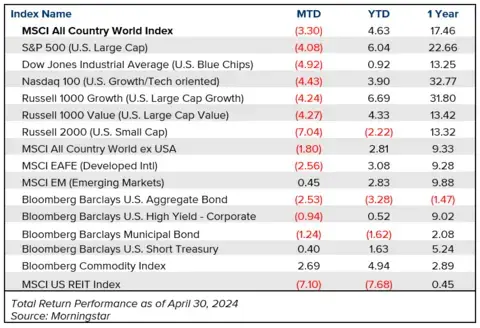For the period April 1 – April 30, 2024.
Executive Summary
Equity markets pulled back in April amid hawkish repricing of rate expectations. Inflation has proven to be stickier than most believed at the start of the year, but following the most recent Fed meeting, it still seems that the next interest rate move will be lower.
What Piqued Our Interest
On April 25, the initial estimate of first-quarter GDP came in at 1.6%, which was well below expectations of 2.5%. This coincided with a stronger-than-expected Personal Consumption Expenditures (PCE) print, which stoked concerns about whether we are heading towards a period of stagflation. While the headline grabbed some attention, the soft GDP print might not have been as bad as initially perceived.
One way to get a better gauge of U.S. domestic spending, which historically accounts for about 70% of U.S. growth, is to strip out net exports, inventory changes, and government spending from GDP. Net trade and inventories can be highly volatile, and in the first quarter of 2024, we saw a significant drag on GDP due to restocking inventories and net imports relative to exports. Even though the cumulative effect was a -1.3% drag on GDP, the rationale behind the moves reflected solid demand for consumer goods.
Other components of GDP were mixed but mostly positive. Government spending slowed, but residential investment—the purchasing of private homes to use as rental properties—saw substantial growth. Overall “Real Domestic Final Purchases” grew by 3.1% at an annualized rate, which is arguably a better way to measure the resilience of the economy and likely a better indicator of what to expect in the second quarter.
The persistence of the U.S. consumer and a resilient (but tightening) labor market are some of the factors contributing to the recent surprising inflation data. Consumer Price Index (CPI) inflation has surpassed expectations each month this year, most recently posting a 3.5% gain in March. PCE inflation, which the Fed prefers because it more accurately reflects what consumers actually spend, rose 2.7% year-over-year—or 2.8% when stripping out food and energy. But overall, the warmer inflation can mostly be attributed to just a few factors: shelter, home and auto insurance, and health care. All of these are noncyclical components that are less sensitive to broader economic conditions.
The Fed held rates steady at their most recent Federal Open Market Committee (FOMC) meeting on May 1, to no one’s surprise. Fed chief Jerome Powell indicated in his post-meeting conference that the next rate move was unlikely to be a hike, which certainly soothed the markets in the short run. Ultimately, the strength (or weakness) of the labor market is likely to determine when the first rate cut will occur. The U.S. economy added 175,000 jobs in April, the smallest gain in six months, even as wage growth accelerated in the first quarter to its highest level in a year. As job growth slows, the probability of rate cuts this year should marginally increase.
Market Recap

After three strong months in a row to start the year, equities retreated off their recently established highs in April. U.S. Large Caps declined by 4.08% as measured by the S&P 500, which is still up 6.04% on the year. As the market pulled back, Utilities were the top-performing S&P sector (+1.65%), followed by Energy (-0.76%) and Consumer Staples (-0.89%), a notably defensive shift relative to the start of the year. For the year, Communication Services is still the top-performing sector at +13.42%, followed by Energy at +12.82% and Financials at +7.76%. Public REITs are the lone negative sector at -9.0%, while Information Technology has fallen to the middle of the pack at +6.57%. Small Caps once again lagged Large Caps, as the Russell 2000 fell -7.04% and is now negative on the year. Despite a stronger U.S. dollar, international stocks performed better than the U.S., as the developed EAFE index fell -2.56% and Emerging Markets gained +0.45%.
Yields rose in April, with the 10-year Treasury going from 4.2% to 4.69% as investors adjusted expectations for fewer rate cuts in 2024. Meanwhile, the yield on the 2-year Treasury went from 4.59% to 5.04% over the same period. According to Bloomberg, this was only the second time since 1994 that the 2-year yield has risen at least 30 bps between consecutive Fed meetings that featured no rate moves—the prior occasion occurring in 1996. This resulted in another tough month for the Bloomberg/Barclay’s U.S. Aggregate Bond Index, which is now -3.28% this year. High-yield bonds and Municipals fared slightly better, but only the Short Treasury index eked out positive gains for the month.
Closing Thoughts
The market has become fully consumed with every piece of macro data and word of “Fedspeak” that might signal the next interest rate move. Expectations for cuts in 2024 have swung from six or seven to start the year to one or two. This volatility is likely to continue until the data fully supports the necessity to lower interest rates.
Meanwhile, the economy continues to perform for several reasons. First, both consumers and businesses are generally less interest rate-sensitive today relative to prior business cycles. Many consumers have locked in low mortgage rates, and the same can be said for much of corporate America and their debt financing. The “higher for longer” narrative simply doesn’t have the same impact as it used to. Second, both cyclical and structural forces continue to boost the economy. Between the various fiscal packages (CHIPS Act, Inflation Reduction Act, Infrastructure Act, etc.) and the overall easier financial conditions, which began towards the end of 2023, there are strong demand tailwinds that are keeping economic activity mostly positive. Even though the Q1 GDP was a bit of a disappointment, forecasts for the rest of the year do not seem daunting—for now. The market may still correct further as rate expectations flutter, but this should not surprise anyone, nor should it impact your investment strategy.
This information is not intended as a recommendation. The opinions are subject to change at any time, and no forecasts can be guaranteed. Investment decisions should always be made based on an investor's specific circumstances.




